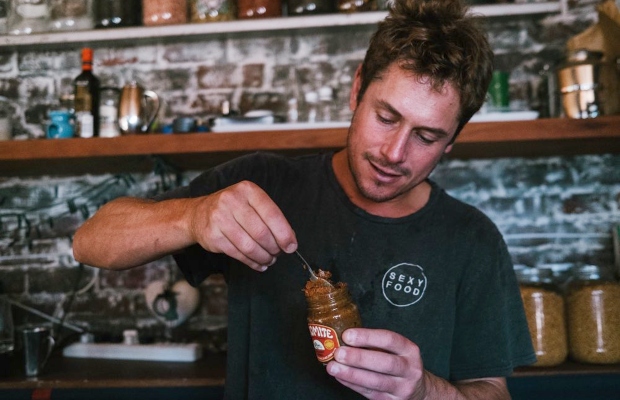James Kuiper, founder of Sexy Food, has spent the last few years perfecting the art of miso making. He now makes and sells South Africa’s first indigenous miso, Misomite.
As I step through the wooden door of a clay outhouse in the garden of James’ home in Scarborough, Cape Town, I am welcomed into his world of fermentation. James is a master fermenter who has spent years studying traditional Eastern and African methods of fermentation. His passion for fermentation is infectious, and he invites me to join him for a day of learning about the ancient craft of fermentation, indigenous philosophies, and intuitive healing.
As we move between the clay fermentation “caves” – built in the style of traditional rondavels – James shares his philosophy on fermentation. He explains how the repetitive actions of tending to the good bacteria cultures train the mind and promote a feeling of calm. He also explains how the living cultures connect the food to the place where it is made, and to the body that finally ingests it.
During my visit, James introduces me to his miso-making process. People often talk about fermented foods as a recent trend, but the techniques are thousands of years old. James has spent years studying traditional Eastern and African methods of fermentation, and he walks me through the different stages of the living foods in his fermentary.
Miso is a fermented paste, made from a mash of cooked soybeans, koji and salt. Miso is made in two stages, first a positive fungus is grown on rice or barley to produce koji and then the koji produces enzymes that break down protein and starch. Wild yeast, lactic acid bacteria and acetic acid bacteria also add to the flavour as the miso ages. Time, bacteria and fungus come together to make this fantastic paste.
We taste, stir and sip the various misos, kefirs, koji and pickled vegetables that James has made. The flavours are salty, rich and deeply umami. His vats of miso have been maturing for up to three years and you can taste the complexity.
James’ miso is locally made and has a unique flavour profile that celebrates the ingredients of South Africa. James explains, “I use local ingredients to make my miso, and I think it’s essential to celebrate the flavours of South Africa.” In various ferments he uses foraged seaweed, or fynbos from the mountain.
James has just started offering one-day foundation workshops and four-day immersive retreats in his Scarborough home. The workshops cover the basics of fermentation, while the retreats offer a more in-depth exploration of the practice, and include yoga sessions, wildlife walks, foraging and cold-water immersions. The beach is just a five-minute walk, and James encourages his guests to take a dip in the ice-cold blue sea.
Aside from the hands-on demonstrations, James also offers the opportunity to begin fermentation projects of your own under his guidance. You can begin a pickling process that harnesses wild bacteria in the environment to pickle and preserve vegetables.
James has personal experience with the healing properties of cultured food. He was diagnosed with lymph cancer at just 17 and after intensive chemotherapy and years of feeling knocked, he found that probiotic-rich food gave him the tools to heal himself. “I still see getting cancer as a blessing. It made me re-evaluate everything,” he tells me.
At the end of the day, I have a newfound appreciation for the art of fermentation and the health benefits of pre- and probiotics. I take with me a couple of jars of James’ two-year-old miso, which he calls Misomite, a reference to the yeasty marmite-like taste and the powerful flavour. The savoury paste is set to be the base of soups, marinades and sauces in my kitchen for a while.
Miso has been a staple in Japanese cuisine for centuries and it is exciting to have a truly artisanal, South African version of the umami-rich condiment.
ALSO READ: 9 recipes that highlight the umami-rich versatility of miso paste

